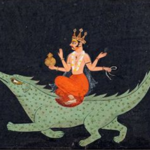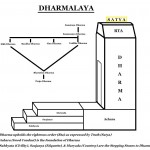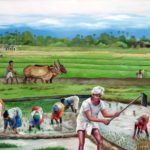Dharma, Artha, Kama, Moksha. Words that are known to almost every serious Dharmic person, since almost birth. Perhaps the ultimate irony is that a spiritual and cultural tradition long critiqued for religious extremes of self-abnegation and fatalism on the one end and Kamasutra and Khajuraho on the other, has always been one of balance. This is where the criticism of knowing more and more about less and less becomes highly relevant, as those using the outsider (etic) lens have studied the tradition only from the basis of a specific external framework. [5] The result is not objectivity, but obtuseness. The theory is force-fitted to the data. Or the data itself is self-selecting, with research areas being divided and sub-divided into oblivion.
That is why it is important that a tradition first be studied holistically and systemically, before moving on to more specialized areas and sub-parts. As the core of Dharma has to some degree been discussed, we may now move on to another central concept: Purusharthas – The Four Aims of Life.
Some of the favourite responses of youth of all generations have been “no one told me this before!”, “there is no guidebook to life!”, or my personal favourite “my body didn’t come with instructions!” [name that movie]. But the rejoinder is in fact “yes” to all of the above. You were told this before, there is a guidebook to life, and your body did come with instructions. You just chose to ignore all of the above because your motto to date has been “if it feels good, do it!”. In all fairness though, perhaps the channel or the communicator of these ideas may not have been the best or most effective.
The natural next query is “well, if we’re not supposed to do x, y, z, then why give it to us to begin with?”.
It is precisely this line of thinking that has been used by those with agendas and ulterior motives since the dawn of time. Through sophistry, casuistry, false equivalence, and half-information, they have sought to misinterpret and misguide (much like modern-day “indologists”) the naive or unschooled in order to advance their own purposes.
And there begins the importance of The Purusharthas.
It is not “see, but don’t touch”, but “touch, in the right circumstances”, it is not “touch, but don’ t taste”, but “taste, only if it doesn’t harm someone”. It is not “taste, but don’t swallow”, but “swallow, only if it doesn’t harm you”.
It is not that sensory pleasure is in itself bad, but when it becomes a fixation, when it becomes an obsession, then we become subject to it, we become a slave to it. And when we become subject or a slave to the dictates of our senses, then consideration for the safety and well-being or dignity or respect of others or our family name goes out the door. Without Dharma, Artha and Kama become subject to Asura, and Moksha goes by the wayside.
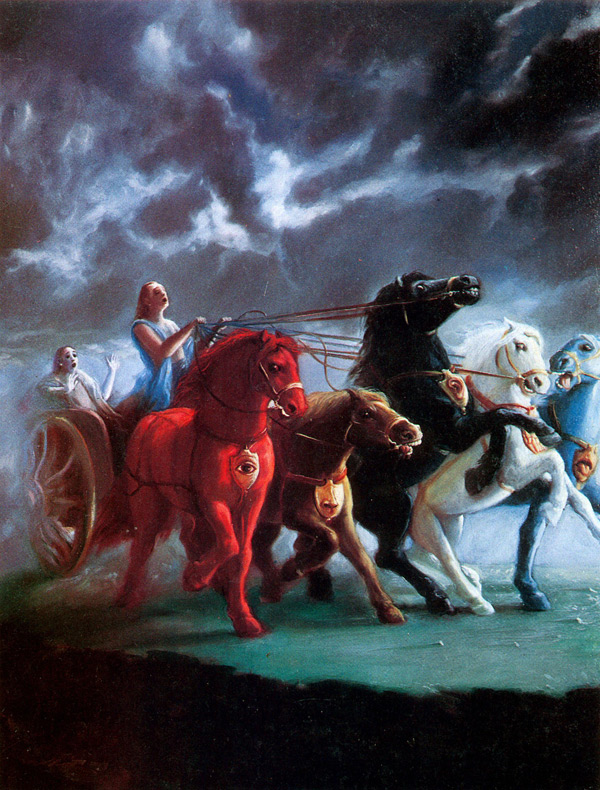
That is the brilliance of the chariot metaphor in the Bhagavad Gita. The Soul is Arjuna, the Charioteer is Krishna, the senses are the horses, and the body is the chariot. With Krishna (who not only represents God, but Dharma itself) guiding the chariot, the horses are properly reined in and we smoothly traverse the journey of life attaining our objectives and reaching our destination. But without a good charioteer, the horses (a.k.a senses) run wild, and the chariot overturns, and our life is ruined. That is how misery in this life and the next, and the next, is fermented.
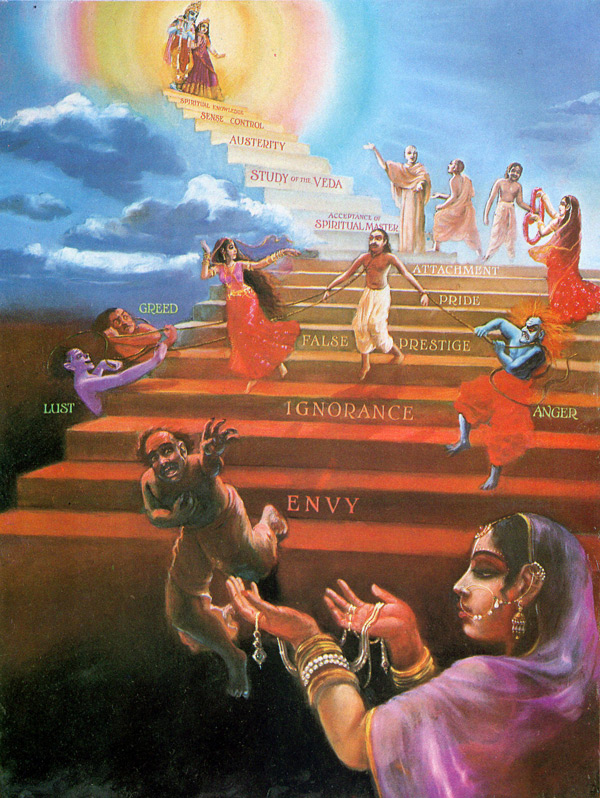
This is the danger of becoming a slave to our senses. And this is why the root of all happiness is in victory over the senses. When we achieve victory over the senses (Indriya-vijayam), then we need not worry or feel guilty on those occasions when we do indulge in sensory pleasures. While other traditions treat sex as something dirty, in the Dharmic tradition, when done correctly, it is not. Even Acharya Chanakya wrote that:
Na jithendhriyaanaam vishayabhayam | 262
Those who have control over their senses are not afraid of their indulgence in sensual delights. [1,p. 160]
And that is why Dharma, both the spirit (inner) and the letter (outer), exists. With Dharma as the guide, with Dharma as the Rules of the Game, we can engage in play (in this material world via this corporeal birth) without self-harm and harm to others. And that is also why Dharma is the most important of the Purusharthas. This is because with mastery of Dharma, we then know how to handle artha (wealth) and kama (pleasure and love) when they come to us. And rather than moksha being something distant that we hurriedly and belatedly seek in our sixties or seventies, it becomes something we prepare for along the way, all our life. What’s more, through Dharma, we understand that our quest for moksha should not cause harm or neglect to others and lead to Adharma.
But of course, victory over the senses, and even practice of Dharma is far more difficult than it may sound here. The former takes many lifetimes for most jeevatmas, and the latter involves many falls even among the most disciplined and dharmic of souls. That is also why ahankar is the greatest impediment to enjoyment of the purusharthas. Aham kar (I am doing). Aham (the great, I am). This thought is in fact the seed of our destruction because it ignores the reality of “we”. When there is only aham, we are only accountable to ourselves and what we hold in importance. When there is hum, then “we” think of our obligations to others. That is why we take only what we need, or enjoy only what is proper.
Dharma
Dharma is the foundational aim of life because it guides all others. It provides us with the Rules of the Game of Life so that we may navigate it happily and attain the ultimate goal of liberation from samsara. Too often individuals believe they can either live a miserable but moral life, or a sinful but happy life. Dharma teaches us that happiness and morality are not mutually exclusive. Even Acharya Chanakya, proponent of Lokayata, and ruthlessly pragmatic, himself wrote “Sukhasya moolam Dharmah”, the root of happiness is Dharma. This is because Kama (sensory pleasure & love) and Artha (wealth/material gain) are not immoral. It is only when desire for either of those two becomes excessive, that we become immoral, and in the long run, unhappy. As Swami Vivekananda reportedly said
What is poison?— Anything in excess
Dharma is the compass that allows us to navigate the map of life. By following it, we can continue on the right path, while enjoying the pleasant sights and sounds and experiences of life. As per Dharma, sex is not wrong. As per Dharma, even enjoying sex is not wrong. Dharma in fact celebrates sexual union of husband and wife as a microcosm of the union of Shiva and Shakti. It only cautions against sexual excess, and advises both husband and wife to experience sex under the guidance of Dharma, and through the bond of matrimony. In fact, that is what the act is meant to create: pair-bonding.
Similarly, the once magnificently wealthy civilization of India did not condemn wealth, why would it? It merely advised against miserliness and greed. That is why Acharya Chanakya wrote “arthasya moolam rajyam, rajasya moolam indrivijayam”, the root of wealth is power, and the root of power is victory over the senses. Therefore, Dharma exists not to deny us pleasure, but only to ensure pleasure and wealth are enjoyed without harming others or ourselves. Do not take what is not yours, that is the essence of Dharma.

Artha is in fact very important to the functioning of society. It allows men (and women) to provide for their families, permits governments to ensure security, law and order, and well-being for the people; and above all, it allows individuals to finance dharmic causes.
Artha
Traditionally, Artha was to be pursued even before Kama, or at least the means to achieving it, to be secured before pursuing Kama. This is because as all men know, having a woman in your life can be very expensive! But beyond that, possession of Artha means being able to successfully undertake one’s duties and obligations. How can we run off and seek pleasure when our parents are unsheltered? How can we engage in reckless abandon when our children are starving? That is the value of artha.
So important is wealth, that Sanatana Dharma propounds the worship of wealth so as to not only acquire it, but to have the sense to use it wisely. That is why we worship wealth in the form of Lakshmi, so we do not lose wisdom (Buddhi).
Wealth comes in different forms. As embodied by the symbolism of Ashtalakshmi, there are 8 traditional froms of wealth: Dhana Lakshmi (Money & Precious metals), Dhaanya Lakshmi (agricultural wealth), Dhairya Lakshmi (courage), Veerya Lakshmi (valour), Vijaya Lakshmi (victory in life), Vidya Lakshmi (scholarly wealth, i.e. education), Rajya Lakshm i(political wealth, empires), Gaja Lakshmi (animal wealth), and Santhaana Lakshmi (family wealth & progeny) . This is why we worship the Goddess of Wealth, because she is the bestower of all these different forms of Artha, we ask for her grace so that we may value, and deploy wisely what we have. After all, “a fool and his money are soon parted”. Dharma ensures that charity begins at home, but that money is also used charitably. It is also why Dharma stipulates that women be respected, because women of the family, especially one’s wife, represent Griha Lakshmi (Lakshmi of the House).
As can be seen in the coin above, Artha when combined with Dharma, allows us to use wealth wisely. It also encourages us to spend within our means (unlike the current model of debt-financed consumption). Dharma teaches us the value of money. When we know the value of money, the real value of money, we use it wisely and for the benefit not just of the senses, but of society at large.
Selfishness is not a virtue. How could it be? Only the severely stupid suffering under the illusion of knowledge, think it so. Selfishness is in fact the Real Root of all Evil. Sophists, casuists, and the half-educated forever tout the import of “Self-interest”, but they forget that even Adam Smith advocated Enlightened self-interest and also emphasised the importance of benevolence.
The man who spends wisely, but liberally, is the man whom others enjoy being around. The man who doesn’t pinch every penny, who doesn’t nickel and dime his friends, is the man whom others seek out as a friend. The woman who respects her husband’s earnings and who spends within the family’s means, is the woman who is in turn respected as the protectress and matriarch (present or future) of her family. This is because, as all honest and self-made businessmen and businesswomen know, business is not about a number.
Mahatma Vidura , the enlightened Prime Minister and half-brother of Dhritarashtra, himself noted this important fact that true profit is holistic and systemic, rather than extractive. Accordingly, he advocated a balance among the Purusharthas as can be seen below in a quote from his celebrated Vidura Niti.
He that followeth virtue, profit, and desire in proper seasons, obtaineth hereafter, a combination of all three.
He that desires the highest success in all matters connected with worldly profit, should from the very beginning practise virtue [Dharma], for true profit is never separated from Heaven [2]
Kama
Pleasure comes in many forms. Because the most literal meaning of Kama is defined as the act or aim of desire (iccha), Kama, like Artha, has many categories. There is of course the most obvious sensual pleasure. In fact, Kama has become so associated with the sensual that it is frequently conflated with Rati (the erotic). But Kama is greater than that and actually means much, much more.
In some contexts, it means Love, as we know from the famous Art of Love. What most do not realise, however, is that the Kamasutra is in fact a manual on how to win the affection of and marry a good wife. Therefore, Love or Affection too is a form of pleasure. In fact, due to its expansiveness to not just refering to the affection of a lover, or a mother, or our family, or even our fellow citizens, it is frequently the most addictive form of pleasure. The desire to be loved by all is a universal one for all normal people. While the erotic pleasures are primarily chemical in nature, the desire for affection is an emotional one. Therefore, affectionate love too is subject to Dharma as Prema cannot become Moha.
 Maslow’s Hierarchy of Needs is said to be a digested form of Indic teaching. While this may in fact be the case, it is nevertheless instructive here to understand the pyramid of Kama.
Maslow’s Hierarchy of Needs is said to be a digested form of Indic teaching. While this may in fact be the case, it is nevertheless instructive here to understand the pyramid of Kama.
As can be seen with the 7 chakras of traditional Yoga Philosophy, there are varying degrees of spiritual evolution. Most people are focused on the Muladhara, which is responsible for the primal drives to reproduce, etc. More spiritually aware beings are focused on the Ajna so that they may eventually open the Sahasraara Padma (Thousand Petalled Lotus), which is the topmost chakra, and connects us with the Divine. The mundane pleasures of the Muladhara far exceeded by the ecstasy achieved when the Sahasraara Padma is opened. But the Muladhara also contains the Kundalini, therefore, the same energy responsible for primal drives, when applied intelligently, rises up to open up the highest levels of spirituality–that is the logic of Tantra (or more correctly, Kaula). Rather than chasing after lower level pleasures for our entire lives, like children craving candy, we are told to exercise self-restraint and engage in moderation. That is also why we are told to guard our thoughts and desires. This is because as we desire, so we become.
Sa yathaakaamo bhavati, tat kratur bhavati, yat kratur bhavati, tat karma kurute, yat karma kurute, tat abhisampadyate. [4, 272]
The best known paraphrase is as follows:
As your desire, so your will. As your will, so your deed. As your deed, so your destiny.
This famous line from the Brihadaranyaka Upanishad (IV, 4, 5) discusses the importance of guarding not only our actions, but our thoughts and inner-most desires as well. That is why a good person can still do a bad thing. He may exercise self-control, but if he is mentally chasing after lower level or forbidden pleasures, he will eventually commit the acts to obtain them. If he continues to repeat the bad thing, that he ultimately becomes bad. As our deeds, so our character. As our character, so our destiny…
That is the Law of Kama. Because Kama is subject to Karma, it should be guided by Dharma. When this is so, we can happily engage in sensual pleasures without fear of sin.
But ultimately, even sensual pleasures have their time limit—that is why we age. There is nothing sadder than an octogenarian still clinging onto the pleasures of youth or lusting after one with youth. A life dedicated to only pleasure is one that is bereft of accomplishment. Looking back on one’s life, it is the achievements we count, not the individual units of utility we drew from each pleasure. What have we done with our life? Whom have helped? Where are we remembered fondly? That is what matters not only for a fulfilling life, but also for one that will ultimately takes us to the Ultimate Truth.
Moksha
Veda, Dharmasastra, Bhagavad Gita, Dhammapada, etc, all of these guide us to ultimate Liberation. Jeevanmukti, Kaivalya.
Moksha is the highest Purushartha because it is the one that takes us to the Ultimate Reality. Artha and Kama are both fleeting and linked to the ephemeral material world. Dharma guides us through the material world, but Moksha is the ultimate aim for all living beings.
The endless cycle of births and deaths is the root of our suffering. Because we are attached to assorted pleasures, the attachment itself (moha) becomes bondage. It is the source of our grief, the source of our pain, the root of our troubles, because we mistake the fleeting for the ever-lasting.
Wealth cannot be taken with us into the next life. Youth and Beauty are impermanent. Even family moves on after we are gone. Therefore, it is best to pursue a life full of Love of and Prosperity, but also one that recognises the importance of spirituality and tapas (ascetism). By thinking of Moksha throughout our lives, rather than just at the very end, we we can be best prepared to attain it, as well as the sensory pleasures of life along the way.
Therefore, young or old, man or woman, Four Ashramas or Eightfold path, all individuals should aspire towards Moksha. It is Moksha that frees us from the bonds of samsara and the grief of moha. It is the path to Moksha, Dharma, that guides us through life so that we may enjoy Artha and Kama while ultimately attaining Moksha.
The concept of the Purusharthas exists to guide us through the ocean of life. Merely chasing after wealth and pleasure takes us through numberless iterations of births and deaths. The truly full life recognises that Artha and Kama are certainly important (after all, all work and no play…), but is also aware of the necessity of Dharma and the ultimate liberative quality of Moksha.
Conclusion
As stated by Mahatma Vidura, he (or she) that seeks out Dharma, Artha, and Kama in proper measure and season, ultimately obtains all three and attains Moksha–that is the fullest life of all. The one that wisely seeks out all four of the purusharthas rather than just one, is the life that breaks the cycle of endless births and deaths and reaches the Divine and everlasting. All work and no play makes Jack a Dull boy. But all play and no work makes Jack a dumb boy.
A life wisely spent is one that first learns Dharma (and Niti) at a young age, then obtains Artha (beginning with Vidya artha) from 6-16 or 26 (depending on our educational path), then Kama (from 18 or 28, etc), and then concentrates on Moksha (from at least age 50 on, if not sooner). Because none of us knows exactly how long we will be on this Earth, it is best to have all four in our mind as we journey through life. A life focused purely on Moksha may neglect the rest of society. A life focused purely on Kama, destroys it. Therefore, individuals must seek harmony among the purusharthas.
In summary, the Purusharthas are the Four Aims of Life because life is not meant to be aimless. Merely meandering through each ashrama (stage/phase of life) is no way to live and will merely lead to endless lives. Idleness, after all, is the mother of all vice. Idle minds lead to idle lives. For society to function, for the world to function, all must contribute. All must be producers of some sort, not just of produce, but of knowledge, or arts, or music, or good government, or wealth, or re-contextualisation of philosophy. When we consume the fruits without toiling to produce it (or something else), we do not know its value.
That is why Artha and Kama are both subject to Dharma. Dharma mandates not that all are subject to an unaccountable king or priest, but ensures that the king and priest perform their obligations and duties to society with humility. A king (or politician) who only believes he should enjoy wealth and pleasure, will inevitably seek to appropriate the Artha (wealth) of the state and prey upon prajas for pleasure. That is the root of corruption.
Corruption is not some black magic ailment that magically appears in society. Corruption occurs when The Purusharthas are not in balance. A life that pursues Artha and Kama while paying mere lip service to Dharma, will not, cannot, attain Moksha.
The best education is the one that is rooted in Dharma and informed by Niti. This grants us viveka (ability to distinguish between right and wrong) and allows us to separate bad information from good.
But the fullest life of all is one that seeks Dharma.
There is a famous story about King Vikramaditya of Ujjain. The ever vigilant king was also a famed adherent of the truth. One night, when he was silently guarding his capital incognito, he saw a beautiful woman, verily a Devi, clad in red, leave the city. He stopped her, asking, “Oh Devi, who are you and why are you leaving?“. She responded, “I am the Goddess of Power. I am leaving this city as the citizens have become criminal, and it is no longer a fit abode for me”. “I understand“, replied Vikramaditya .
Then, another beautiful lady, clad in gold, began leaving. Vikramaditya asked her too “Oh Devi, who are you and why are you leaving?“. She replied, “Oh Maharaja, I am the Goddess of Wealth. I am leaving your capital as the citizens have become corrupt, and it is no longer a fit abode for me”. “I understand“, Vikramaditya relented again.
Finally, a third beautiful lady, clad in white, began leaving. Vikramaditya asked her too, “Oh Devi, who are you and why are you leaving?” She replied, “Oh Rajan, I am the Goddess of Truth. I am leaving your people as they have become immoral”. This time Vikramaditya said “Oh Devi, please do not leave. I can live a life without Power and Wealth, but I cannot live a life without Truth. I beg you, please stay in my kingdom“. The Goddess smiled, and said “So, be it.”.
Soon, the Goddess of Wealth returned. Surprised, Vikramaditya asked “Oh Devi, why have you returned?“. She replied “I am the Goddess of Wealth, I reside where Truth resides”. Then finally the Goddess of Power returned. Amazed, Vikramaditya asked “Oh Devi, why have you returned?”. She replied “I am the Goddess of Power, I reside where Wealth resides”.
The moral of the story, of course, is that power, wealth, pleasure, all can be given up in the name of Truth (of which Dharma is the expression), because they are dependent upon it. This is because men and women of character can lose every material possession in the world, every opportunity for pleasure, every right of power, but keep their character is in their own hands. If character is lost, then all is lost. That is the thinking of the Dharmic Man and Woman, so they prize their character, their Dharma, above Artha and Kama, and even Moksha, because they know Dharma is the path to all three, and therefore, a balanced and harmonious life that is ultimately fruitful.
https://www.youtube.com/watch?v=9lKfgTuJc-0
But if all this is not enough. If you still only care about acquisition of Artha & Kama. If you are not interested in Moksha, don’t have time for Jnana, and care not for the Adhyatmika, let me end with the Laukika for all you materialistic pragmatists. The essential reality of The Purusharthas was contained in the very same Epic Poem that contained the transcendental Song of the Lord you heard above.
The essence of the Mahabharata, the Ramayana, and the Purushartha was summed up as follows by Maharishi Veda Vyasa himself:
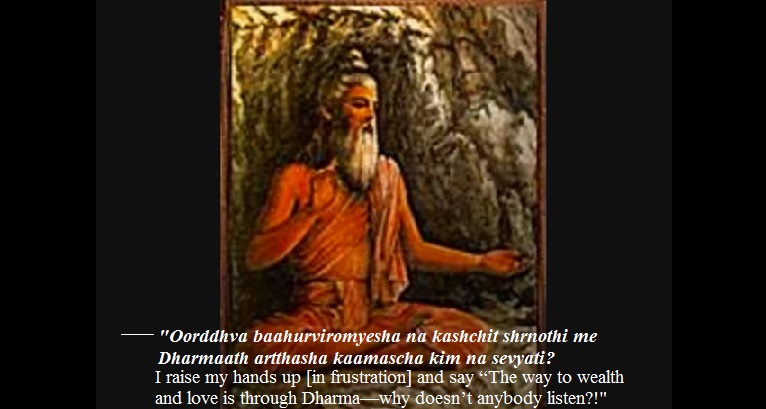
References:
- Chaturvedi, B.K.Chanakya Neeti.Diamond: New Delhi.2015
- Vidura Niti. p.150
- Rangarajan, L.N.. Kautilya. Arthashastra. New Delhi: Penguin.1991
- Radhakrishnan, Sarvepalli. The Principal Upanisads. London: Unwin Brothers. 1968
- Malhotra, Rajiv. “Insiders versus Outsiders: Who Speaks for Our Heritage?”. Infinity Foundation. 2016 http://rajivmalhotra.com/books/the-battle-for-sanskrit/insiders-versus-outsiders-who-speaks-for-our-heritage/










